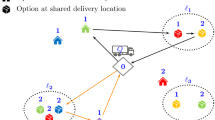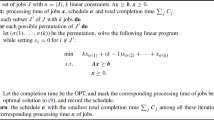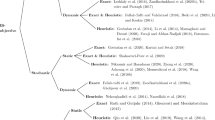Abstract
Given the locations of J customers, their demands and I capacitated facilities, the Capacitated Multi-facility Weber Problem (CMWP) is concerned with locating I facilities in the plane to satisfy the demand of J customers with the minimum total transportation cost which is proportional to the distance between them. We propose two types of branch and bound algorithms for the ℓ r distance CMWP with 1≤r<∞. One of them is an allocation space based branch and bound algorithm for which a new branching variable selection strategy and new lower bounding procedures have been proposed. The other one is new and partitions the location space. Based on extensive computational experiments we can say that the proposed algorithms are promising and perform better than the existing ones.


Similar content being viewed by others
References
Akyüz, M. H., Öncan, T., & Altınel, İ. K. (2012). Efficient approximate solution methods for the multi-commodity capacitated multi-facility Weber problem. Computers & Operations Research, 39, 225–237.
Al-Loughani, L. (1997). Algorithmic approaches for solving the Euclidean distance location-allocation problems. PhD thesis, Virginia Polytechnic Institute and State University, Virginia, USA.
Aras, N., Yumuşak, S., & Altınel, İ. K. (2006). Solving the capacitated multi-facility Weber problem by simulated annealing, threshold accepting and genetic algorithms. In K. F. Doerner, M. Gendreau, P. Greistorfer, W. J. Gutjahr, R. F. Hartl & M. Reimann (Eds.), Metaheuristics—progress in complex systems optimization (pp. 91–112). New York: Springer.
Aras, N., Altınel, İ. K., & Orbay, M. (2007). New heuristic methods for the capacitated multi-facility Weber problem. Naval Research Logistics, 54, 21–32.
Aras, N., Orbay, M., & Altınel, İ. K. (2008). Efficient heuristics for the rectilinear distance capacitated multi-facility Weber problem. Journal of the Operations Research Society, 59, 64–79.
Bazaraa, M. S., Sherali, H. D., & Shetty, C. M. (1993). Nonlinear programming: theory and algorithms (2nd ed.). New Jersey: Wiley.
Boyacı, B. (2009). Solving the capacitated multi-facility Weber problem approximately. MS thesis, Boğaziçi University, İstanbul, Türkiye.
Brimberg, J., & Love, R. F. (1993). Global convergence of a generalized iterative procedure for the minisum location problem with l p distances. Operations Research, 41, 1153–1163.
Brimberg, J., Chen, R., & Chen, D. (1998). Accelerating convergence in the Fermat–Weber location problem. Operations Research Letters, 22, 151–157.
Cooper, L. (1972). The transportation-location problem. Operations Research, 20, 94–108.
Drezner, Z., & Suzuki, A. (2004). The big triangle small triangle method for the solution of nonconvex facility location problems. Operations Research, 52, 128–135.
Drezner, Z., Wesolowsky, G. O., & Drezner, T. (2004). The gradual covering problem. Naval Research Logistics, 51, 841–855.
Drezner, Z., Wesolowsky, G. O., & Drezner, T. (2007). A general global optimization approach for solving location problems in the plane. Journal of Global Optimization, 37, 305–319.
Drezner, Z., Drezner, T., & Wesolowsky, G. O. (2009). Location with acceleration–deceleration distance. European Journal of Operational Research, 198, 157–164.
Frenk, J. B. G., Melo, M. T., & Zhang, S. (1994). A Weiszfeld method for a generalized l p distance minisum location model in continuous space. European Journal of Operational Research, 2, 111–117.
Geoffrion, A. M. (1997). Integer programming by implicit enumeration and Balas’ method. SIAM Review, 9, 178–190.
Hansen, P., Perreur, J., & Thisse, F. (1980). Location theory, dominance and convexity: some further results. Operations Research, 28, 1241–1250.
Hansen, P., Peeters, D., & Thisse, F. (1981). On the location of an obnoxious facility. Sistemi Urbani, 3, 299–317.
Held, M., Wolfe, P., & Crowder, H. P. (1974). Validation of subgradient optimization. Mathematical Programming, 6, 62–88.
Idrissi, H., Loridan, P., & Michelot, C. (1988). Approximation of solutions for location problems. Journal of Optimization Theory and Applications, 56, 127–143.
Korovkin, P. P. (1986). Inequalities. Moscow: Mir.
Luis, M., Salhi, S., & Nagy, G. (2009). Region-rejection based heuristics for the capacitated multi-source Weber problem. Computers & Operations Research, 36, 2007–2017.
Luis, M., Salhi, S., & Nagy, G. (2011). A guided reactive GRASP for the capacitated multi-source Weber problem. Computers & Operations Research, 38, 1014–1024.
Martello, S., & Toth, P. (1990). Knapsack problems: algorithms and computer implementations. New York: Wiley.
Plastria, F. (1992). GBSSS—the generalized big square small square method for planar single-facility location. European Journal of Operational Research, 62, 163–174.
Selim, S. (1979). Biconvex programming and deterministic and stochastic location allocation problems. PhD thesis, Georgia Institute of Technology, Atlanta, USA.
Sherali, H. D., & Adams, W. P. (1999). A reformulation-linearization technique for solving discrete and continuous nonconvex problems. Dordrecht: Kluwer Academic.
Sherali, H. D., & Nordai, F. L. (1988). Np-hard, capacitated, balanced p-median problems on a chain graph with a continuum of link demands. Mathematics of Operations Research, 13, 32–49.
Sherali, H. D., & Tunçbilek, C. H. (1992). A squared-Euclidean distance location–allocation problem. Naval Research Logistics, 39, 447–469.
Sherali, H. D., Ramachandran, S., & Kim, S. (1994). A localization and reformulation discrete programming approach for the rectilinear distance location–allocation problems. Discrete Applied Mathematics, 49, 357–378.
Sherali, H. D., Al-Loughani, I., & Subramanian, S. (2002). Global optimization procedures for the capacitated Euclidean and l p distance multifacility location-allocation problem. Operations Research, 50, 443–448.
Thisse, J. F., Ward, J. E., & Wendell, R. E. (1984). Some properties of location problems with block and round norms. Operations Research, 32, 1309–1327.
Ward, J. E., & Wendell, R. E. (1985). Using block norms for location modeling. Operations Research, 33, 1074–1090.
Weiszfeld, E. (1937). Sur le point lequel la somme des distances de n points donné est minimum. Tôhoku Mathematics Journal, 43, 355–386.
Weiszfeld, E., & Plastria, F. (2009). On the point for which the sum of the distances to n given points is minimum. Annals of Operations Research, 167, 7–41.
Wendell, R. E., & Hurter, A. P. (1973). Location theory, dominance and convexity. Operations Research, 21, 314–320.
Witzgall, C. (1964). Optimal location of central facility: mathematical models and concepts (Report No. 8388). National Bureau of Standards (NBS).
Zainuddin, Z. M., & Salhi, S. (2007). A perturbation-based heuristic for the capacitated multisource Weber problem. European Journal of Operational Research, 179, 1194–1207.
Author information
Authors and Affiliations
Corresponding author
Additional information
This research is supported by the Turkish Scientific and Technological Research Council (TÜBİTAK) Research Grant No: 107M462, and Galatasaray University Scientific Research Projects Grant Nos: 07.402.014, 10.402.001 and 10.402.019. The first author acknowledges the partial support of National Graduate Scholarship Program for PhD Students awarded by TÜBİTAK.
Rights and permissions
About this article
Cite this article
Akyüz, M.H., Altınel, İ.K. & Öncan, T. Location and allocation based branch and bound algorithms for the capacitated multi-facility Weber problem. Ann Oper Res 222, 45–71 (2014). https://doi.org/10.1007/s10479-012-1221-3
Published:
Issue Date:
DOI: https://doi.org/10.1007/s10479-012-1221-3




